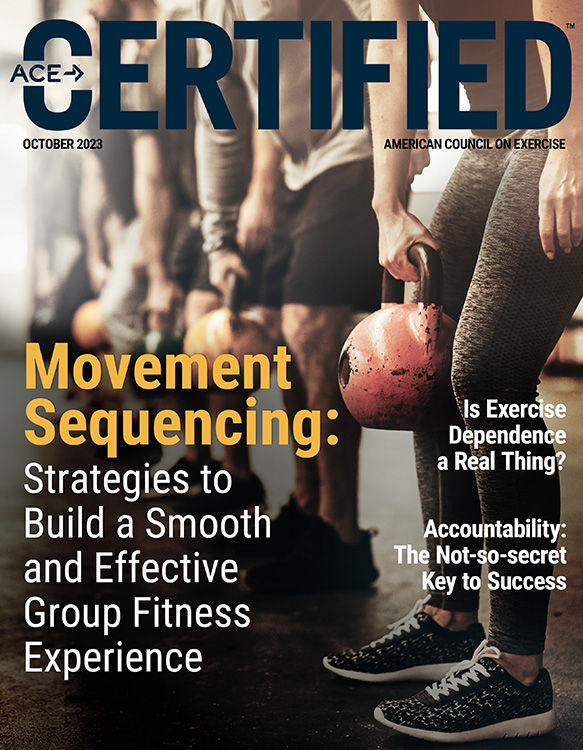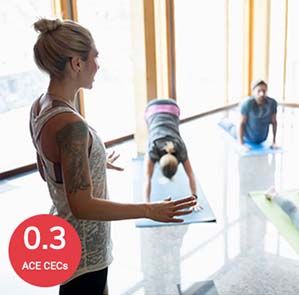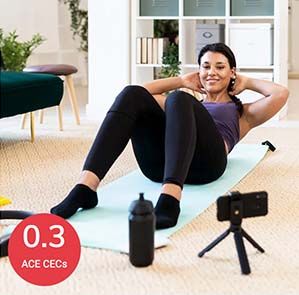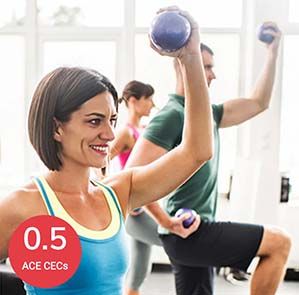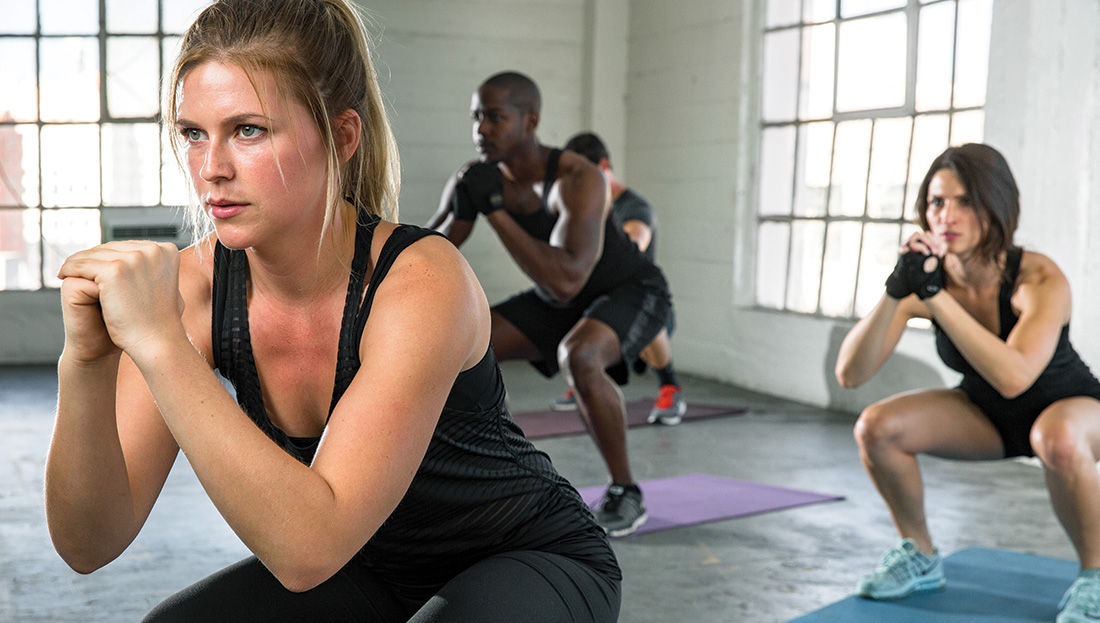
Group fitness instruction is deceptively complex and requires a high level of multitasking. The art of being a successful ACE Certified Group Fitness Instructor (GFI) lies in the ability to create a safe and effective exercise experience while juggling everything from a tentative newcomer walking through the door at the last second to a class veteran casually mentioning an injury during the warm-up, from weather derailing your plans for an outdoor boot-camp class to your microphone or speakers failing while you’re trying to cue a complex movement.
And, despite every obstacle or distraction that might arise, you have to keep it fun, modify movements for participants at different fitness and ability levels (and that newly revealed injury), and make sure everyone leaves with a smile on their faces and eager to return for your next class.
Sounds simple enough!
One key to managing all of this involves building a sound class plan that features smooth transitions and movements that feel natural and purposeful to both you and your participants. In addition, you must apply principles of exercise science to structure and sequence a class properly.
Of course, the guiding principle of any group fitness class is safety. “Safety first” is a cliché for good reason. No other objective of class design, whether it’s progressive overload or upping the fun factor, can take precedence over participant safety.
Jan Schroeder, PhD, a professor in the Department of Kinesiology at Long Beach State University who leads several group fitness classes in the community each week, reveals that safety is the first thing she thinks about when developing a class. “You have to think about your clientele and what is safe for them,” she says.
Also, safety shouldn’t be viewed as a barrier to creating an engaging and exciting class. “When we keep safety in mind, we are constantly providing our participants with options and education,” explains Lisa (Reynolds) Bevers, owner of Lisa Reynolds Fitness. “So, as I’m introducing something new, I’m educating them on the ‘why’ and providing options in an inclusive manner.”
Here, Schroeder, Bevers and Staci Alden, another veteran GFI, offer strategies for properly sequencing movements in a way that will serve you well no matter what types of classes you teach.
Start with the Basics: Class Objective and Demographics
The class objective ought to drive much of your decision making, from exercise selection to music. For example, the primary goal of a dance-based class may be to improve cardiorespiratory endurance, while the goal of a yoga class may be to reduce stress levels. Not only would those disparate goals impact the types of exercises chosen, but also the order in which they are performed.
One strategy that Schroeder shares in her class “Theory and Analysis of Group Exercise Instruction,” is to work in reverse. For example, you may teach a class where the goal is to perform a complex combination of movements at the end of the hour. In that case, you might think about the components of that movement and slowly unpack them so your participants are building the necessary skills as they move through class.
Alden, an ACE Certified Group Fitness Instructor and Personal Trainer and owner of Alden Fitness Solutions, also considers the overall feeling and experience she wants to create for each class. To accomplish this, Alden likes to build her class in four quarters or blocks that run alongside the traditional warm-up, conditioning segment and cool-down. The idea is to sequence movements so that participants are learning a new skill, for example, over the course of the class as you simultaneously manage the appropriate changes in intensity.
Bevers, who teaches a Sensible Sequencing course for yoga instructors, agrees that it’s best to start with the objective or the “meat and potatoes” of the workout. “Is there a particular body focus I have in mind?” she askes herself. “Am I doing a strength-training class working from large muscle groups to small or from small to large? If it’s a yoga flow, am I picking a particular peak posture that I’m working up towards?”
What Does the Science Tell Us About Exercise Sequencing?
When structuring a group fitness class, it’s important to consider the different types of exercises you will be including and how they will be sequenced. Research tells us that sequencing cardiorespiratory and muscular-training activities later in an exercise session or class, after various other movements have been performed, can result in higher-than-expected physiological responses and poorer training responses.
“Not only are these responses undesirable, but they could also negatively influence your participants’ long-term adherence to group exercise,” explains lead researcher Lance Dalleck, PhD. “Given this, it makes sense to incorporate movements focused on cardiorespiratory and/or muscular fitness earlier in a group fitness class.”
In addition, Dalleck and his colleagues found that exercisers can optimize their results by performing cardiorespiratory exercise before resistance training. The outcomes of flexibility and/or neuromotor training seem to be less influenced by where they are sequenced in an overall group fitness class or other exercise session.
So, if you are teaching hybrid classes that feature more than one type of exercise, consider leading participants through cardio work before strength training, with flexibility and neuromotor exercises rounding out the end of class.
The demographics of the classes you teach is another primary driver of movement sequencing. Bevers teaches yoga, Pilates, barre, dance, cardio and strength classes, not to mention various fusions of those formats. To complicate matters even further, she teaches classes at the Cooper Institute (where most participants are older adults), as well as at boutique studios, a yoga studio and a country club.
To make things easier on herself when designing classes for the different demographics and settings, Bevers often uses a framework that she knows works for one demographic and then customizes it to meet the needs of another. For example, she may slow the tempo or replace movements that require balancing on one foot with exercises that allow an older population to stand with both feet on the ground, and then offer more or less intense options, as appropriate.
Those different facilities not only have dramatically different vibes, but they also have different types of equipment available. Therefore, Bevers is also prepared to teach within her “framework” with various types of equipment—or none at all.
Clearly, what feels like a free and easy exercise experience for participants requires a lot of planning and forethought so that that you’re not reinventing the wheel every time you sit down to design a class. Bevers uses her proven frameworks “so that I’m not coming up with 20 classes a week. I can modify and adjust within that framework.”
Consider Exercise Effectiveness
Alongside safety, exercise effectiveness is a guiding principle of group fitness instruction. After all, there’s a reason the phrase “safe and effective” is used frequently throughout ACE’s textbooks when describing exercise sessions and group fitness classes. Those are the two primary concerns when programming any workout.
Just as each class should have an overall objective, each exercise or movement should as well. This is where things like neuromuscular balance come into play. As Alden explains, “I want to make sure they’re getting flexion, extension, side bending, etc. I like to think of my class as, where is the spine moving? Where are their bodies moving? Are they moving forward, back and side to side? Are they pushing, pulling and rotating?” Alden says it’s important for her to keep her classes very dynamic, as she works with a lot of working professionals who are sitting at their desks all day—another connection between movement selection/sequencing and demographics.
Make the Most of Your Warm-up and Cool-down
The warm-up should include rehearsal moves and serve as a preview of the movements that will be performed during class. Letting participants know what’s to come can make a class run more smoothly. For example, Alden will state explicitly when a movement will show up again later on: “Remember that lunge twist. We’ll be adding weight to it later on.” That way, the participants become a bit more comfortable, and it demonstrates to them the level of preparation that goes into building the class design.
Alden also highlights the cool-down as a time that many instructors may not take full advantage of. For example, you might walk the participants through the way you built them up toward achieving the class objective over the course of your time together that day by layering movements into one more complex exercise or sequence. The cool-down is a great time to be an educator in addition to a fitness instructor.
Make Smooth Transitions
Transitions can take many forms in the group fitness room—from standing work to floor work, from cardio to strength, from one piece of equipment to the next and so on. In all cases, the goal should be to simplify things as much as possible.
Alden recommends using no more than three types of equipment in a class (aside from a yoga mat), so that might mean a set of dumbbells and a balance trainer of some kind, or bands and a stability ball. Otherwise, the space can become cluttered and even dangerous.
When mapping out a class on paper, it can be easy to lose sight of things like where you would ask participants to place their equipment. For example, if you have participants position their dumbbells to their right during the strength-training component of class but then have them perform grapevines later on, you’ve created a scenario where either they have to pause to move the equipment or face a tripping hazard.
Bevers also suggests using a piece of equipment for consecutive movements before moving to the next, and using those transitions strategically so they serve as well-timed breaks.
Schroeder, who was an also an editor and contributor to ACE’s latest textbook—The Exercise Professional’s Guide to Group Fitness Instruction—and the 2021 IDEA Fitness Leader of the Year, concurs that limiting equipment is vital. If more than three pieces of equipment are needed for a class, she recommends teaching a circuit-style class rather than having each participant clutter their space.
Alden likes to take advantage of certain movements to help participants transition from standing exercise to floor-based exercise. For example, rather than finishing a set of squats and then telling the class to move to their backs for some abdominal work, Alden might end a set of lunges by telling them to lower the back knee to the floor on their last rep and then move to the floor from that position. It’s a much easier transition that way. Then, she can do the same in reverse to return to standing work.
From the “rules are made to be broken” school of thought, Schroeder says that while she typically has her participants perform all of their standing work before transitioning to the floor, there are times when she’ll mix that up if it suits the demographics of the class and the overall objective. If she’s working with a group of healthy folks over 50, for example, she may have them move from the floor to standing several times during a class, if learning that skill is one of the class objectives. (One caveat: She doesn’t do that very often because, as she says, “they don’t like it!”)
Alden also suggests that instructors think about their participants’ heart rates and avoid moving directly from a cardio interval, for example, to supine work. Instead, allow the heart and respiratory rates to slow more gradually by performing a transitional movement or two between those extremes. In addition to considering how heart rate might be impacted during transitions, it’s important to think about changes in blood pressure that may occur when rising from a reclined position to an upright position. A decrease in blood pressure that occurs when quickly moving from the floor to seated or standing positions is known as orthostatic hypotension and this rapid change in blood pressure may lead to dizziness. Gradually moving between these positions is recommended, especially when working with older adults or individuals using medications such as beta blockers, which can blunt the heart-rate response.
As always, safety first.
Final Thoughts
Schroeder offers one more bit of advice: Don’t let your desire for participants to enjoy your class—to focus on the “fun factor”—supercede your knowledge of exercise science or participant safety. A certain sequence of movements may be really fun to perform or provide a unique challenge, but that doesn’t mean it’s the best choice for your participants. They may not have the fitness or skill level, or they may not have adequate balance or strength.
Bevers offers a callback to the “framework” idea mentioned above as a way to use sequencing as a tool to build a sense of community in your classes, which is an essential element of participant enjoyment and drives long-term adherence. For example, she will sometimes call back to a previous class and explain that the goal is to build on that experience: “We worked on single-legged deadlifts last week, so I want those of you who were here last time to reflect on how you’re getting stronger when we perform that movement today. Let’s celebrate that improvement!”
Bevers will typically plan her classes and movement sequencing a month at a time and look for opportunities to make those connections from week to week or even from modality to modality. Sequencing is a sometimes-overlooked tool in the GFI’s arsenal, but when used effectively, it can help participants progress from week to week, develop continuity across experiences and enhance participant enjoyment and camaraderie. As Bevers explains, sequencing movements is not about having a new party trick every week but instead about building classes that are safe, effective and, yes, fun.
Expand Your Knowledge
Creating Impactful Group Fitness Classes – Course Bundle
Gain a deeper level of understanding of group fitness and the application of teaching strategies so you can safely and effectively guide your class participants, regardless of fitness or skill level. The
Creating Impactful Group Fitness Classes course bundle will get you up to speed on effective coaching techniques and strategies so you can guide your class participants to their individual fitness goals.
Virtual Group Fitness Instructor Toolkit – Course Bundle
The increase in demand for online group classes is the perfect opportunity for you to take your skills and business into the virtual world—where you can not only stay connected with current participants but reach new ones you never would’ve before. The Virtual Group Fitness Instructor Toolkit course bundle will give you best practices in providing memorable virtual workouts and building your online presence.
How to Be a Dynamic Group Fitness Instructor
Group fitness instruction is more than developing a sequence of exercises—it’s also about engaging each participant and understanding what each person needs in order to get the most out of the class. With this course, discover how you can be your best as an instructor so you can offer inspiring class experiences, and learn the fundamental teaching principles that will enable you to teach dynamic classes. You will train your eye to view and assess compensations and good form in numerous functional movements, and you will discover how to assist people in improving these movements through correct cueing and muscular awareness. Through brilliant teaching, your classes will be engaging and motivating, keeping your participants coming back for more.





 by
by 